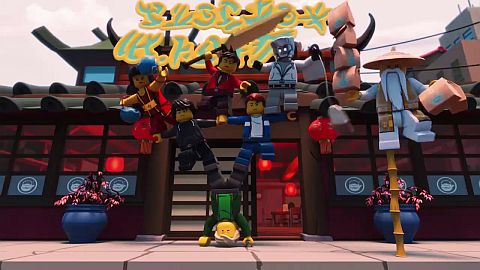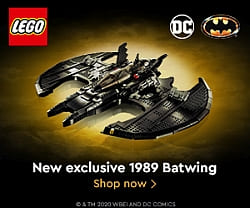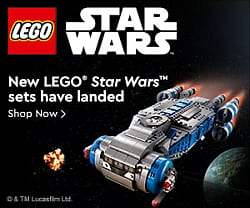Last year, we discussed a very unique and rare LEGO Education set that was released to commemorate the widening of the Panama Canal (see original announcement here: LEGO Education Panama Canal). At that time, the #2000451 LEGO Education Panama Canal was only available in Panama, so it was very difficult to get hold of a copy. The only viable option was eBay, where resellers were asking for around twice as much as the original price. However, now the set is available directly from the Panama STEM Education website, with free shipping to the US (also available to other countries with standard shipping charges). So let’s take a second look at this unusual LEGO set. 🙂
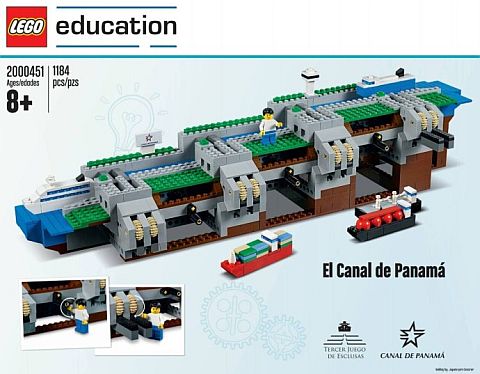
The #2000451 LEGO Education Panama Canal was originally intended for educators to demonstrate to students how a series of locks allow ships to go through the famous canal, while compensating for the height difference between sea level and the level of Gatun Lake. You can see all the action features of the set in the video below.
As you can see, this 1,184-piece set is quite massive, and it is built in five sections (plus the ships), so several children can work on it at the same time. The structure is somewhat unfinished looking compared to standard LEGO consumer sets, but the focus here is on demonstrating the moving parts and mechanics of the canal. The little ships, on the other hand, are very well designed micro-models. Production of the set was limited to 40,000 units, which makes it even more unique. (Image below: map of the Panama Canal with gates leading to and leaving Gatun Lake – source Wikipedia)

According to the description at the Panama STEM Education website, the #2000451 LEGO Education Panama Canal simulates a functional model of the Panama Canal and its Third Set of Locks, and has the proper approval by the Authority of the Panama Canal for its manufacture and commercialization. The set also simulates the water levels of the chambers and allows them to rise or fall, and demonstrates the independent double gate system in each of the lock chambers. Five different types of ships that transit through the Panama Canal are also included. Full color instructions. 1,184 pieces. Price: $249.95

I also like the description of how teachers can incorporate the set in various areas of education: 1.) Determine the importance of the evolution of the means of transport and means of communication, with the purpose of improving the quality of life of the people. 2.) Recognize the importance of the means of communication of the Republic of Panama, as a source that facilitates the development of the different activities of its people in accordance with scientific and technological progress. 3.) Highlight Panama’s participation in economic activities and trade relations with the countries of the Americas and other continents. 4.) Establish the geographical position and characteristics of the most outstanding geographical landscape of the country and the importance of its conservation for its social, political, cultural and economic development. 5.) Highlight the most significant historical events in the country and the repercussions for the present life. 6.) Use length, mass and other units of the International System, relating their equivalences and conversions to solve problems of daily life with satisfaction.
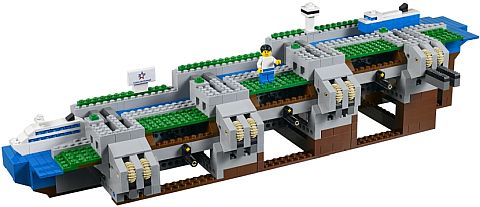
Due to the limited release, uniqueness, and historical significance of the set, the #2000451 LEGO Education Panama Canal is obviously of interest to collectors. However, there are some plusses and minuses to consider before handing over your hard-earned dollars. The original price of $250 is quite expensive for a 1,184-piece set (21 cents/piece), especially when considering that all parts are standard. So, it’s mainly the box and the instructions that you are paying extra for. It’s not an unreasonable price for a collectors item, but not the best either. (Please note that I included a $50 off promo code below that will help with the total price, but I don’t know how long it will work, so use it while you can.)
If you are only interested in the design of the set, you should be able to build it from parts from your own collection, however I was not able to find online instructions at this point. Below, I have included a video-review of the set from BrickTsar so you can see the box, the content, the instructions, and the assembled model in more detail.
If you would like to buy the LEGO Education Panama Canal, you can go directly to the Panama STEM Education website to purchase it. If you are in the US, choose Free Priority Mail International Shipping (8-10 days), and you can also use the following promo code to get 20% off the $249.95 price: CMSY6UJXWT (as I mentioned above, I don’t know how long this promo code is going to work). Your total should look like the image below. (The set is also available to other countries with standard shipping charges).

And if you are interested – especially if you are a teacher – you can also take a look at the LEGO Education website to learn more about what they offer. For adults, LEGO has another educational program called LEGO Serious Play (click on link to visit their website) with sets that can be found under the LEGO Serious Play section of the Online LEGO Shop.
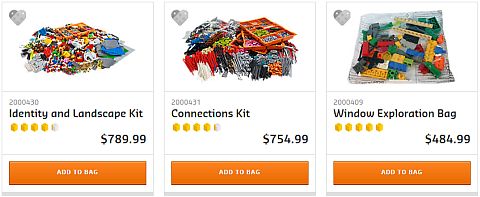
What do you think? How do you like the LEGO Education Panama Canal? Would you be interested in buying it? Or are you inspired to build your own? Do you think LEGO should release similar educational sets in their regular product lines? Feel free to share your thoughts and discuss in the comment section below! 😉
And you might also like to check out the following related posts:
- LEGO Education Panama Canal
- Build LEGO Robots with Yantra Robotics
- Starting Out with LEGO Robotics
- Making of a LEGO Paper Plane Machine
- LEGO Mindstorms Easter Egg Decorator Robot
- LEGO Mindstorms Robot – LEGONADRO the Artist
- Walking LEGO Animals – So Much Fun!
- LEGO Pop-Ups & More Magical Creations
- LEGO Mindstorms the Ultimate Useless Machine
- The Great LEGO Ball Contraption…


